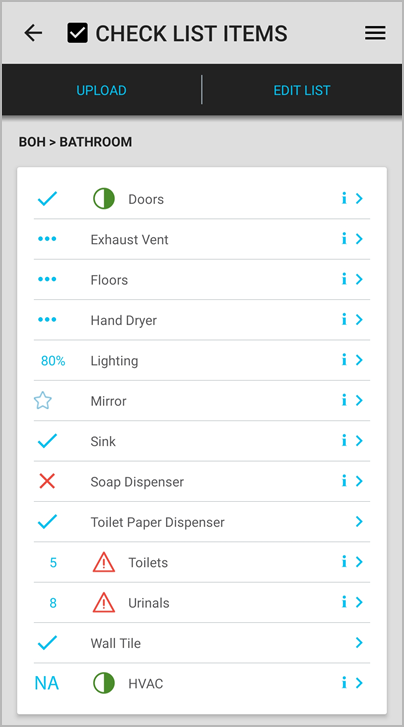Starting a New Audit and Viewing the Details of the Audit Pages
At the start of an audit, you want to ensure you have the right location, audit type, and checklists. When starting a new audit, you have pre-configured areas and checklists that are set up by your Site Planning Manager configurator. During the audit, you may modify the checklists and checklist items available.
You can start a new audit in SC Mobile at any time as long as at least one audit type and one location are configured and available in the app. You can have up to 10 audits in Open or In Progress at a time across all locations. When conducting multiple audits at one location, different templates must be used for each audit.
- On the Site Audits page, tap New Audit +. The list of locations appears.
Locate and tap the desired location. The list of available audit types appears.
Should you not see a list of audit types, speak with your ServiceChannel system administrator.
- Tap the desired audit type. The audit appears listing the areas and checklists to inspect.

From here, you may begin conducting an audit.
Details of an Audit
Site Planning Manager has three main pages to assist you with conducting an audit.
| Page | Description |
|---|---|
| Audit: List of the area(s) that need to be audited, along with its corresponding checklist(s).
|
| Check List Items: Lists all checklist items within the current checklist in an area. To go to the Check List Items page, tap the desired checklist. Rating. To the left of each checklist item are 3 blue dots. These dots indicate that the item has not been rated. In the image on the left, Exhaust Vent, Floors, and Hand Dryer have not been rated. Tap the blue dots to activate and cycle through the rating system. Find out more about the available rating systems. Depending on the rating system configured for each checklist item, you may see the following ratings:
Check List Item impact. Some checklist items may have different importance. A warning sign means this is a Veto item that has the highest impact on the audit score. A semi-filled circle marks an Ignore item that is ignored when the audit score is calculated. In the image on the left, Toilet and Urinal are Veto items, while Air Conditioner is an Ignore item. Instructions. To the right of some checklist items, you may see a blue "i". This indicates that this item contains instructions that may guide you towards auditing the item correctly. Instructions are listed on the Audit page. |
| Checklist: Contains the rating, instructions, previous audit data, and other inspection options. To go to the Audit page, tap the blue arrow next to the desired checklist item.
|
-
Page:
-
Page:
-
Page:
-
Page:
-
Page:
-
Page:
-
Page:
-
Page:
.jpg?version=1&modificationDate=1541693650471&cacheVersion=1&api=v2&width=225&height=400)




